Avro York Video - Avro York Operations - 1948
|
|
Avro York
Type 685 York
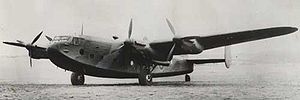
Picture - LV633 "Ascalon," Churchill's personal aircraft.
Role: Transport
Manufacturer: Avro
Designed by: Roy Chadwick
First flight: 5 July 1942
Introduced: 1944
Retired: 1964
Status: Two examples on display
Primary users: Royal Air Force
BOAC; British South American Airways; Skyways Ltd
Produced: 1943 - 1947
Number built: 259 (including prototypes)
Developed from: Avro Lancaster
The Avro York was a British transport aircraft that was derived from the Second World War Lancaster heavy bomber, and used in both military and airliner roles between 1943 and 1964.
Design and development
Called the Avro type 685, development began in 1941. The design paired a new "squared-off" fuselage with the wings, tail and undercarriage of the Lancaster bomber. Production was undertaken by Avro with the hopes of sales to the Royal Air Force and in the postwar civil airliner market.
The prototype, LV626, was assembled by Avro's experimental flight department at Manchester's Ringway Airport and first flew there on 5 July 1942. It had initially been fitted with the twin fins and rudders of the Lancaster but the increased fuselage side area forward of the wing compared to the Lancaster necessitated fitting a third central fin to retain adequate control and directional stability. Initial assembly and testing of production Yorks mainly for the RAF, was at Ringway, later Yeadon (Leeds) and Woodford (Cheshire).
One pattern aircraft was built at Victory Aircraft in Canada but no further orders were received. Victory tooled up for 30 aircraft and built parts for five with one ultimately being completed about the time the war came to an end.
Operational history
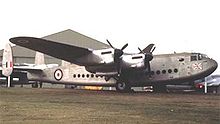
Picture - RAF York
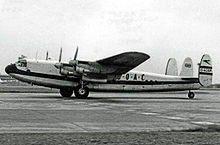
Picture - BOAC York operating a freight schedule at Heathrow in 1953
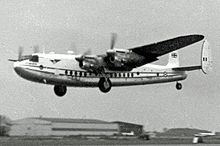
Picture - Air Charter York taking off from London Stansted in 1955 on a trooping flight through the Suez Canal Zone
The first civilian York (G-AGJA), initially built for the RAF as MW103, was delivered from Ringway to British Overseas Airways Corporation (BOAC) in February 1944. In RAF Transport Command service, the York was used on the England-India route.
Production orders included 50 civilian Yorks and 208 military versions to the RAF - many of which subsequently passed into civilian hands. During the Berlin Airlift, Yorks flew over 58,000 sorties - close to half of the British contribution, alongside the Douglas Dakota and Handley Page Hastings. During wartime years they also served as VIP transport aircraft.
In the postwar years, BOAC used Yorks on their Cairo to Durban service, which had previously been worked by Shorts flying-boats. They were also used by British South American Airways (BSAAC) on their routes to the Caribbean and South America, until their merger into BOAC in September 1949. BOAC's Yorks continued to operate freight schedules until November 1957 when the last example was withdrawn.
After disposal by BOAC and BSAAC, their York fleets were purchased by several UK independent airlines and operated on both passenger and freight flights. These included long distance trooping flights to Jamaica and other UK garrisons. The last Yorks were retired from service by Skyways and Dan Air in 1964.
When the Distant Early Warning Line (Dew Line) was being constructed in Canada in the late 1950s, the Avro York was introduced as a freighter by Associated Airways. At least one of the Yorks, CF-HAS, was retained, and was in service with Transair as late as 1961.
Specials
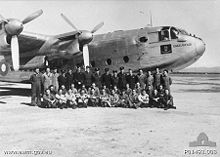
Picture - Members of the Governor-General's Flight in front of the Vice-Regal Avro York aircraft in June 1945
The Avro York was, like its Lancaster and Lincoln stablemates, a very versatile aircraft. One of the prototype Yorks, LV633, Ascalon, was custom-built as the personal transport and flying conference room for Prime Minister Winston Churchill. Ascalon was to be fitted with a special pressurised "egg" so that VIP passengers could be carried without their having to use an oxygen mask. Made of aluminium alloy it had eight perspex windows to reduce claustrophobia. It also had a telephone, instrument panel, drinking facilities and an ashtray with room for cigars, thermos flask, newspapers and books. Testing at RAE Farnborough found the "egg" to work satisfactorily. However, Avro said it was too busy with the new Lancaster IV (Avro Lincoln) work so it was never actually installed in Ascalon. It was considered for installation in the successor aircraft, a Douglas C-54B but the contractor Armstrong Whitworth decided it was impractical and the project was shelved. The whereabouts of "Churchill's Egg" is currently unknown.
MW104, Endeavour, flew to Australia in 1945 to become the personal aircraft of HRH The Duke of Gloucester, Australia's then Governor-General. It was operated by the Governor-General's Flight from 1945 to 1947, and it was the Royal Australian Air Force's only York.
Another York, MW102 was fitted out as a "flying office" for the use of Viceroy of India and C-in-C South East Asia Command, Lord Mountbatten. During its first major overhaul by Avro at Manchester (Ringway) in 1945, the aircraft was re-painted a light duck egg green, a shade intended to cool down the aeroplane, instead of its former normal camouflage colour scheme.
South African leader Jan Smuts also used a York as personal transport.
Air Chief Marshal Sir Trafford Leigh-Mallory was killed 14 November 1944 while flying to his new posting in Ceylon to take command of Allied air operations in the Pacific, when York, MW126, struck a ridge in the French Alps in a blizzard, 30 mi (48 km) S of Grenoble, France. His wife Dora and eight aircrew also died. Wreckage found by a villager in June 1945.
Variants
York I Four-engined civilian transport aircraft. York C.I Four-engined military transport aircraft for the RAF. York C.II One prototype York aircraft fitted with four Bristol Hercules XVI radial piston engines.
Operators
Military operators
Australia
Royal Australian Air Force
Governor-General's Flight RAAF
France
French Air Force
South Africa
South African Air Force
United Kingdom
Royal Air Force
No. 24 Squadron RAF
No. 40 Squadron RAF
No. 51 Squadron RAF
No. 59 Squadron RAF
No. 99 Squadron RAF
No. 206 Squadron RAF
No. 232 Squadron RAF
No. 242 Squadron RAF
No. 246 Squadron RAF
No. 511 Squadron RAF
Civil operators
Aden
Aden Airways
Argentina
Flota Aérea Mercante Argentina
Iran
Persian Air Services
Lebanon
Middle East Airlines
South Africa
South African Airways
Tropic Airways
United Kingdom
Air Charter
BOAC
British South American Airways
Dan Air
Eagle Aviation
Hunting Clan Air Transport
Scottish Airlines
Skyways
Surrey Flying Services
Survivors
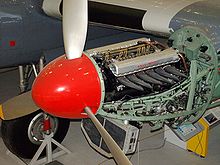
Picture - Restored Rolls-Royce Merlin engine of G-ANTK
While there are no flying examples of the Avro York, there are two complete examples on display. Currently at the RAF Museum Cosford Collection is Avro 685 York C1, TS798 (cn 1223) which was initially intended for the RAF as TS798, but quickly passed to BOAC as G-AGNV and later to Skyways. It was previously preserved at Skyfame (Staverton), Brize Norton and Shawbury.
Another example on public display is held at the Imperial War Museum Duxford: Avro 685 York C1, G-ANTK is an ex-Dan-Air London aircraft. This airframe was built at Yeadon, near Leeds, in January 1946 and entered RAF service with No. 242 Squadron RAF as MW232 that August. It joined the fleet of Allied aircraft engaged in the Berlin Airlift and in May 1947, the York moved to 511 Squadron at Lyneham, where it served until May 1950 when it was used by Fairey Aviation for flight refuelling research. It then retired to 12 Maintenance Unit at Kirkbride for storage prior to disposal. In July 1954, MW232 became G-ANTK with Dan-Air and it was used for freight work until its retirement in May 1964. It was ferried to Lasham Airfield and used as a bunk house by the local Air Scouts until 1974. The Dan-Air preservation group took it over and began to restore the aircraft in their spare time. In the mid-80s, Dan-Air realised the impracticality of the restoration work being undertaken and began negotiations with the Duxford Aviation Society. In May 1986, the aircraft was dismantled and on 23 May made its journey to Duxford on seven low-loaders.
Accidents and incidents
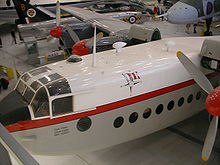
Picture - Dan Air York in Duxford
26 July 1944 a Royal Air Force York crashed after overshooting at Gibralter.
14 November 1944 a RAF York crashed near Grenoble, France.
1 February 1945 a RAF York crashed at Lampedusa Island.
8 February 1945 a RAF York was damaged beyond repair during a landing accident at Mauripur, India.
5 November 1945 a RAF York was damaged beyond repair while landing at Ratmalana, Ceylon.
29 December 1945 a RAF York crashed and was destroyed by fire near New Milton, Hampshire, England.
11 April 1946 a RAF York was damaged beyond repair when the landing gear collapsed on landing at RAF Lyneham.
11 April 1946 a RAF York crashed and burn on take off from RAF Woodbridge, one of the six crew on board was killed.
28 April 1946 a RAF York crashed on landing at RAF Valley, Wales.
23 May 1946 a RAF York crashed while landing at Mauripur, India.
On 7 September 1946 British South American Airways Star Leader took off from Airport at the near of Bathurst, The Gambia. The captain lost control of the aircraft as it was climbing. The accident killed all 24 passengers and crew on board.
9 September 1946 a RAF York was damaged beyond repair after hitting a pony during a landing at Holmesley South, Hampshire.
6 October 1946 a RAF York crashed in the Bay of Bengal.
20 October 1946 a RAF York crashed on take off from Dum Dum, Calcutta, India.
3 November 1946 a RAF York was damaged beyond repair on landing at Delhi-Palam, India.
20 November 1946 a RAF York crashed in the desert south of Helwan, Egypt.
23 December 1946 a Flota Aérea Mercante Argentina York crashed into a mountain 31 km from Rio de Janeiro, Brazil.
28 November 1946 a RAF York crashed on take off from RAF Brize Norton.
2 December 1946 a RAF York crashed short of runway at RAF Luqa, Malta.
19 December 1946 a RAF York was destroyed by fire during maintenance at RAF Honnington.
11 February 1947 a RAF York crashed on landing at RAF Waterbeach.
14 March 1947 a RAF York crashed on landing at RAF Lyneham.
18 March 1947 a RAF York crashed and burnt out near Negombo Town after departure from Negombo, Ceylon.
13 April 1947 British South American Airways Star Speed crashed on landing at Dakar, Senegal.
24 May 1947 a RAF York crashed on landing at Luqa, Malta.
11 June 1947 a RAF York crashed on landing at RAF Oakington.
1 July 1947 a RAF York crashed after overshooting at RAF Oakington.
16 July 1947 a BOAC York crashed near Basra, Iraq.
25 July 1947 a Flota Aérea Mercante Argentina Avro 685 York I crashed at Moron Air Base, Buenos Aires, Argentina, after hitting a lorry shortly after landing.
25 July 1947 a Skyways York was damaged beyond repair on landing at London Heathrow Airport.
2 September 1947 a RAF York crashed and destroyed by fire on landing at RAF Dishforth.
4 September 1947 a RAF York was destroyed by a hangar fire at Habbinya, Iraq.
30 October 1947 a RAF York was damaged beyond repair in a taxying accident at Negombo, Ceylon.
5 November 1947 a RAF York crashed on landing at RAF Lyneham.
16 November 1947 a RAF York crashed on landing at Santa Cruz, Bombay, India.
17 November 1947 a RAF York crashed while overshooting at RAF Dishforth, Yorkshire.
16 February 1948 a RAF York was damaged beyond repair during a landing at RAF Hullavington.
On 4 July 1948 A RAF collided with a Scandinavian Airlines System DC-6 over Northwood, London, killing all seven passengers and crew on the Avro York and 31 passengers and crew on the DC-6. See Northwood mid-air collision.
27 July 1948 a RAF York crashed on landing at RAF Abingdon.
11 August 1948 a RAF York crashed on landing at Desford in Leicestershire.
19 September 1948 a RAF York crashed on take off from Wunstorf, West Germany.
23 September 1948 a RAF York crashed on take off from Wunstorf, West Germany.
10 October 1948 a RAF York crashed on landing at Gatow, West Berlin.
10 November 1948 a RAF York crashed on take off from Wunstorf, West Germany.
2 December 1948 a RAF York crashed on landing at Gatow, West Berlin.
14 December 1948 two RAF Yorks crashed, one on take off and one landing at RAF Gatow, West Berlin.
16 December 1948 a RAF York crashed on landing at RAF Abingdon, Oxfordshire.
5 January 1949 British South American Airways Star Venture crashed at Caravellos Bay, Brazil.
1 February 1949 a RAF York crashed after take off at Castel Benito, Libya.
15 March 1949 a Skyways York crashed on approach to Gatow, West Germany.
21 April 1949 a RAF York was damaged beyond repair during a landing at RAF Gutersloh, West Germany.
19 June 1949 a Skyways York crashed at Neustadt near Wundstorf, British Zone of Germany.
30 July 1949 a RAF York crashed on take off from Wunstorf in the British Zone of Germany.
15 November 1949 a RAF York crashed while landing at Nairobi West instead of Eastleigh in Kenya.
2 June 1950 a RAF York was destroyed by fire following a refuelling accident on the ground at RAF Bassingbourn.
25 October 1950 a RAF York was damaged beyond repair in a landing accident at RAF Changi.
11 March 1952 an Air Charter York crashed near Hamburg, West Germany.
24 August 1952 a Eagle Aviation York crashed on take off from Gatow, West Berlin.
27 November 1952 a Air Charter York was damaged beyond repair landing short of runway at RAF Lyneham, Wiltshire.
On 2 February 1953 a Skyways crashed into sea off Newfoundland (island), Canada after a SOS was called by the pilots. The wreck of the aircraft was never found: all 39 passengers and crew died.
13 April 1954 a Scottish Aviation York was damaged beyond repair landing at Luqa, Malta.
26 June 1954 a Eagle Aviation York crashed landed at Kyritz, East Germany.
22 September 1954 a Scottish Aviation York was damaged beyond repair during take off at RAF Stansted.
11 April 1955 a Associated Airways York crashed on take off at Yellowknife, Canada.
12 April 1955 a Arctic Wings York was damaged beyond repair after hitting a snow bank at Hall Lake, Canada.
26 May 1955 a Associated Airways York was damaged beyond repair after hitting an obstacle on take off from Edmonton Municipal Airport, Canada. [1]
14 September 1955 a Persian Air Services York crashed 40 miles south-east of Basra, Iraq.
29 September 1955 an Associated Airways York was damaged beyond repair after ditching into the Thoa River near Yellowknife, North West Territories, Canada.
24 January 1956 a Maritime Central Airways York was damaged beyond repair during a forced landing at Fort Chimo, Quebec, Canada.
On 18 February 1956 a Scottish Airlines crashed at Malta due to pilot error killing all 50 passengers and crew. See 1956 Scottish Airlines Malta air disaster.
30 April 1956 a Scottish Airlines crashed on take off from Stansted Airport, Essex.
13 September 1956 a Pacific Western Airline York was damaged beyond repair after an accident at Cape Perry, North West Territories, Canada.
13 September 1956 a TransAir York was damaged beyond repair after overunning runway at Fox, Northwest Territories, Canada.
17 September 1956 a Persian Air Services York was destroyed when a fuel tank exploded during maintenance at Stansted Airport, Essex, England.
26 September 1956 a Maritime Central Airways York was damaged beyond repair in a forced landing in Quebec, Canada.
8 January 1957 a TransAir York was destroyed by fire after crash landing on a lake in Hudson Bay, Canada.
On 23 December 1957 a cargo Scottish Airlines crashed near London Stansted Airport on approach to the airport killing all four crew.
20 May 1958 a Dan-Air York was damaged beyond repair while landing at Luqa, Malta.
25 May 1958 a Dan-Air York crashed at Guragon, Punjab, India.
29 September 1958 a Middle East Airlines York went missing over the Mediterrean Sea somewhere between Beirut and Rome.
15 July 1959 a Persian Air Services York crashed nea Kuwait City, Kuwait.
27 May 1960 an Air Liban York was damaged beyond repair on take off from Mehrabhad Airport, Tehran, Iran.
24 May 1961 a Middle East Airlines York crashed during an emergency landing at Azaiba, Muscat.
6 April 1962 a Trans Mediterranean Airways aircraft on lease to Kuwait Airways was damaged beyond repair in a landing accident at Lahore, Pakistan.
11 September 1962 a Middle East Airlines York crashed landed in Saudi Arabia.
15 March 1963 a Middle East Airlines York crashed 7 miles south east of Karai, Iran.
Specifications (Avro York)
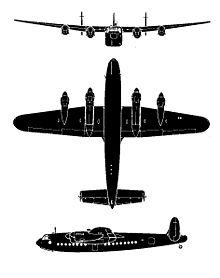
Picture - Avro York
Data from Jane's Fighting Aircraft of World War II
Crew: 5 (two pilots, navigator, wireless operator, cabin steward)
Capacity: 56 passengers
Payload: 20,000 lb (9,100 kg)
Length: 78 ft 6 in (23.9 m)
Wingspan: 102 ft 0 in (31.1 m)
Height: 16 ft 6 in (5 m)
Wing area: 1,297 ft² (120.5 m²)
Empty weight: 40,000 lb (18,150 kg)
Loaded weight: 65,000 lb (29,480 kg)
Powerplant: 4x Rolls-Royce Merlin 24 liquid-cooled V12 engines, 1,280 hp (950 kW) each
Performance
Maximum speed: 298 mph (258 kn, 479 km/h) at 21,000 ft (6,400 m)
Range: 3,000 mi (2,600 nmi, 4,800 km)
Service ceiling: 23,000 ft (7,010 m)
Rate of climb: 820 ft/min (4.2 m/s)
Wing loading: 54 lb/ft² (260 kg/m²)
Power/mass: 0.079 hp/lb (130 W/kg)
Related development
Avro Lancaster
Avro Lancastrian
Comparable aircraft
Armstrong Whitworth Ensign
Airspeed Ambassador
Bibliography
Bridgeman, Leonard. âThe Avro Type 685 York.â Jane's Fighting Aircraft of World War II. London: Studio, 1946. ISBN 1-85170-493-0.
Hannah, Donald. The Avro York (Aircraft in Profile number 168). Leatherhead, Surrey, UK: Profile Publications Ltd., 1967.
Holmes, Harry. Avro - The History of an Aircraft Company. Second edition. Crowood Press, Marlborough, 2004. ISBN 1-86126-651-0
Jackson, A.J. Avro Aircraft since 1908, 2nd edition. London: Putnam Aeronautical Books, 1990. ISBN 0-85177-834-8.
Ottaway, Susan and Ian. Fly With the Stars - A History of British South American Airways. Andover, Hampshire, UK: Speedman Press, 2007. ISBN 978-0-7509-4448-9.
Avro York Pictures and Avro York for Sale.
Living Warbirds: The best warbirds DVD series.
Source: WikiPedia